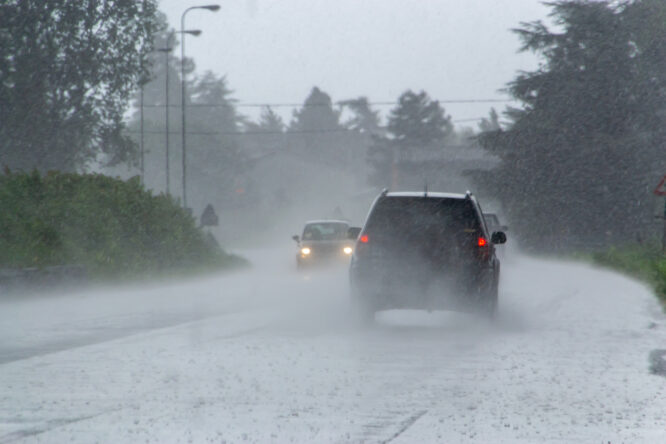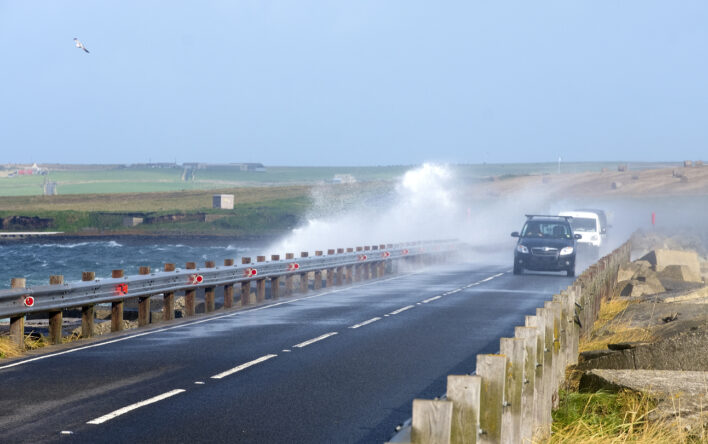Driving in high winds can feel unnerving, and for good reason.

Strong gusts can catch you off guard, especially on open roads or motorways, and even light vehicles can be pushed around without warning. While you might not always be able to avoid windy conditions, there are ways to keep yourself safer behind the wheel when things get blustery.
It’s not just about gripping the wheel a little tighter; it’s about knowing how wind affects your car, what to watch for on the road, and how to adjust your driving accordingly. Here are 10 practical tips to help you stay safe when driving when those good old British winds hit dangerous levels.
1. Keep both hands firmly on the wheel.

It sounds obvious, but it’s one of the most important things you can do. Sudden gusts can jolt your car to the side, especially on exposed roads or bridges. Keeping both hands on the wheel gives you the control you need to stay steady when wind hits unexpectedly.
Even if you usually drive one-handed or relax your grip on long journeys, windy conditions are not the time to be casual. A firm, focused hold can make all the difference in keeping your car stable and your reactions sharp.
2. Reduce your speed.

The faster you’re going, the less time you have to correct your course if a gust hits. High winds can quickly turn a small swerve into a dangerous situation, especially at higher speeds. Slowing down gives you more control and more time to react. It also helps reduce the overall effect wind has on your vehicle. A slower, steadier pace is much safer, and if conditions are bad enough, it’s perfectly okay to go under the speed limit. Safety trumps speed every time.
3. Watch out for high-sided vehicles.

Lorries, buses, and vans are especially vulnerable to strong crosswinds, and if they suddenly sway or shift, it can create a hazard for other drivers. Keep your distance and avoid lingering in their blind spots or alongside them for too long. If you see a large vehicle wobbling slightly in the wind, give them even more space than usual. It’s not about judging their driving; it’s about recognising the risk and steering clear of it where possible.
4. Be cautious when overtaking.

Passing another vehicle in windy conditions can be tricky. As you pull out, you might be shielded from the wind, then suddenly exposed as you move past, causing your car to drift slightly. It can be surprising if you’re not ready for it. If you absolutely have to overtake, do it carefully and with plenty of space. Hold the wheel steady and be ready to gently correct your steering once you clear the vehicle and feel the full force of the wind again.
5. Stay alert on open roads and bridges.

Some stretches of road are more exposed to the wind than others. Open fields, coastal routes, and bridges are notorious for sudden gusts that come out of nowhere. These areas often catch drivers off guard, especially if conditions change quickly. When approaching these spots, it’s smart to slow down slightly and pay closer attention to how your vehicle feels. If you feel it start to drift, gently correct without overreacting. Staying calm and steady is key.
6. Avoid distractions.

Windy conditions demand your full attention. Even small distractions like fiddling with the radio or checking your phone can be enough to miss a sudden shift or sway in your car’s movement. Stay fully focused on the road and your surroundings. If you need to adjust something, pull over safely and sort it out. When the wind’s up, even a quick glance away from the road can put you at risk of losing control or missing what’s happening around you.
7. Keep an eye out for debris.

High winds often come with flying branches, fallen signs, or bits of rubbish blowing across the road. These can create unexpected hazards, especially if you’re driving at speed and can’t swerve in time. Scan the road ahead more frequently than usual, and be ready to slow down or steer around small obstacles. If something larger has blown onto the road, don’t try to swerve sharply—slow down and stop safely if needed.
8. Be extra careful when exiting tunnels or sheltered areas.

Coming out of a tunnel or driving from behind a hill into an open area can hit you with an instant gust of wind you didn’t see coming. That sudden change in conditions can jolt your car and catch you off balance. Ease off the accelerator slightly as you exit, and hold the wheel firmly so you’re ready for the shift. Once you’re out in the open again, adjust smoothly and carry on with care.
9. Know when to pull over and wait it out.

If the wind is making driving genuinely difficult, or you’re feeling too anxious to continue safely, there’s no shame in pulling over and taking a break. Find a safe spot away from trees, signs, or anything that might blow over. Listen to weather updates, check road conditions, and only get back on the road when you feel confident again. Your journey might take a little longer, but your safety isn’t worth rushing for.
10. Keep your car well maintained.

Good tyre tread, proper tyre pressure, working brakes, and stable suspension all help your car handle better in tricky conditions, including wind. If something’s off, even a mild gust can become a bigger issue. Regular checks and basic maintenance can go a long way in helping your car stay grounded and predictable when the weather turns. A well-looked-after vehicle gives you a better chance of staying in control when conditions get unpredictable.




